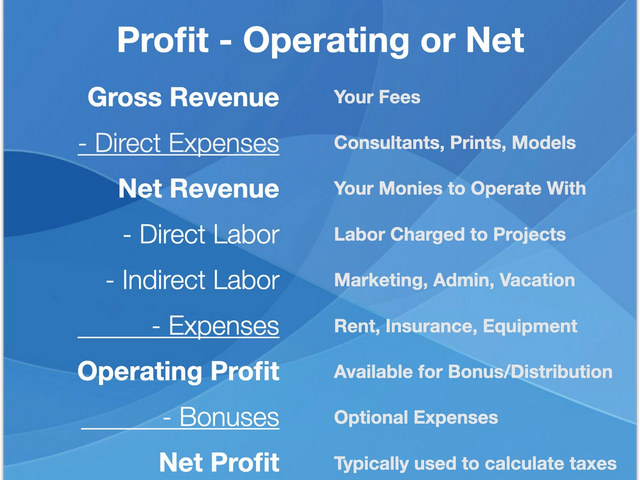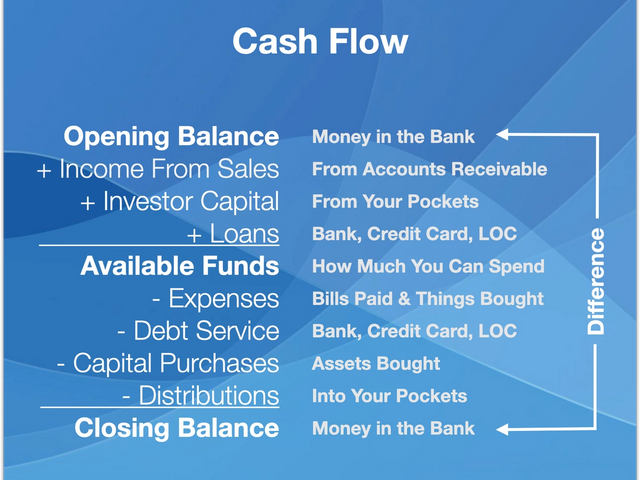Profit vs. Cash Flow

What is Profit and what is Cash Flow? We’re going to clarify the meaning and difference between these two terms. We’re also going to dive into its relevance as it relates to your business and your business’ viability.
Profit
What is profit? Profit is typically what you're going to end up reporting on your taxes. It's going to affect, but it is not, your bank balance. Your bank balance comes from cash flow.
Without profit, your business is not going to last very long. If you don't become profitable, you’ll soon be closing the doors because you won't have an unlimited supply of funds to make up the difference.
There are two kinds of profits:
- Operating Profit
- Net Profit

To calculate your Operating Profit, you must first get your Net Revenue by subtracting your Direct Expenses from your Gross Revenue. After that, you then need to subtract your Direct Labor, Indirect Labor, and Expenses such as rent, Insurance, and Equipment from your Net Revenue.
Now that you have your Operating Profit Value, you now have to subtract the bonuses or other optional expenses from it to get the Value for your Net Profit.
Cash Flow
Cash flow determines your viability. If you don't have a positive cash flow, pretty soon, the bank account is empty, and you’ll be out of business.
You can end up with negative cash flow while making a profit. But if your profit is not enough to cover obligations such as debt service, your bank account will be shrinking even though you're showing a profit. Cash flows can cause bankruptcies, at least when they're negative.
Simply put, cash flow is what's happening in your checking account. Much with the case of profitability, if you have negative cash flows, you are going to be out of business before long.
Cash Flow Calculation
Here’s how the cash flow is calculated.

Start with your opening bank balance or the money you have in the bank, then you're going the add the following:
Income From Sales from accounts receivable.
Investor Capital or the money coming out of your own pocket to get your firm started.
Loans or the money you may have borrowed from the bank to start operating your firm. You could also be growing your credit card balances, or you brought in a line of credit and added money to your bank.
The sum of all those numbers is your available funds.
After you get your available funds, you're going to be paying bills, servicing your debt, or doing capital purchases for your assets. You might make some distributions and put some money in your own pocket—that's always a good thing. Once you’ve subtracted all of those, you’ll get your closing balance.
Cash Flow is the difference between your opening balance and your closing balance. Hopefully, it's going to be positive. But there are times when it will be negative and those times are not always bad.
Negative Profit & Positive Cash Flow
There can be a situation where you have negative profit and positive cash flow. When you put money in from your startup funding, you haven't made a profit yet, but your bank account grew. You may be getting a loan, like the PPP Loans that came during the COVID-19 crisis.
Another reason that might put you in this situation is when your credit card balances are growing. You're covering negative profits with that money, but you're not paying those balances down. Your cash flow is still going up because you're not paying those credit card balances.
It's also possible that you haven't paid your consultants yet. You might also have assets purchased last year that you're getting to depreciate now.
If you're in this situation, it should raise some red flags. You need to know why you are in a negative profit while you're having a positive cash flow. Find out the cause and take action.
Negative Profit & Cash Flow
This isn't a great place to be, but it is typical for startups.
Let's say you funded the company in month one, and now we're into month two. You're not making a profit yet, and you've got your negative cash flows. In that case, it's normal as long as you have enough runway and enough cash in the bank to get you to where you're in the cycle where you are making money and have some positive cash flow.
Having too much overhead and too many expenses can also cause you to be in this situation. Also, having growing accounts receivable when your clients are not paying you yet could be another reason. You need to get that money collected and into the bank, so you can use it for your operations.
Some other reasons for a Negative Profit and Cash Flow might include having back payments to your consultants, Economic slowdowns like the Great Recession in 2009, the COVID-19 Crisis, or Bonus time where you might be paying bonuses out.
Let's say, for example, you've had operating profits of $12,000 and then paid out bonuses. Let's say the bonuses were for the last six months or maybe the last twelve months' worth of work, and you pay out $30,000. You've got a negative profit of $18,000.
Having negative profit and cash flow doesn't mean the end of the world for you. You just have to know why you are having these situations and whether you're negative in your cash flow, profit, or both.
Positive Profit & Negative Cash Flow
If you’re in your debt reduction phase and you’re making money, but it’s not quite enough, you might find yourself in a situation where you have positive profit and negative cash flow. You might be doing this because it’s mandatory. You also might do this voluntarily to get out of debt.
Perhaps you're taking money out of the company as a distribution. It doesn't count as an expense, yet your bank account goes down, which is considered as negative cash flow. This could lead to some financial challenges down the road, or because it's your distributions and you're careful with your money, it may not have any negative effect at all.
Positive Profit & Cash Flow
This is where we all want to be—positive cash flow and positive profits. This is where you want to get to. It is a great place to be, and that's the goal of everything we do. Once you get there, don’t hesitate to do your happy dance because you’ve earned it.
As you’re starting your architecture and engineering firms, you are going out and taking all this risk. All that struggle should lead you to the point where you can be in that happy place and make an excellent living for yourself.
If you enjoyed this post and maybe even learned something, consider sharing it with your colleagues and associates. We want to help as many people and firms as possible reach high levels of success and profitability.
